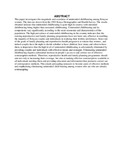The magnitude and correlates of unintended childbearing in Kenya: implications for the family Planning Programme’

View/
Date
2002Author
Ikamari, Lawrence D.E.
Type
ArticleLanguage
enMetadata
Show full item recordAbstract
This paper investigates the magnitude and correlates of unintended childbearing among Kenyan women. The data are drawn from the 1993 Kenya Demographic and Health Survey. The results obtained indicate that unintended childbearing is quite high in country with mistimed childbearing being higher than unwanted childbearing. Unintended childbearing and its components vary significantly according to the socio-economic and characteristics of the population. The high prevalence of unintended childbearing in the country indicates that the existing reproductive and family planning programmes have not been very effective in enabling the majority of Kenyan couples and individuals in realising their fertility preferences. Since one of the goals of family planning and reproductive health program is to ensure that women , and indeed couples have the right to decide whether to have children, how many and when to have them, is imperative that the high level of unintended childbearing is substantially eliminated by providing couples and individuals with effective means and strategies. Eliminating unintended childbearing requires substantial increase in people’s access to and correct use of effective contraception methods. Therefore, reproductive health and family planning programmes should aim not only at increasing their coverage, but also at making effective contraceptives available to all individuals needing them and providing education and information that promotes correct use of contraceptive methods. This entails persuading nonusers to become users of effective methods and emphasising eliminating unintended child bearing among women who are who are already contracepting.
Citation
African Journal of Health SciencesPublisher
Department of Population Studies and Research Institute, University of Nairobi
